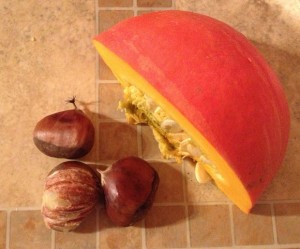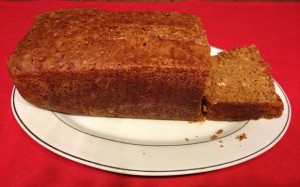I went walking with my new French neighbours in Blois last week. Two and a half hours, sometimes through muddy forest, but I survived and enjoyed it! Fortunately I was wearing my trusty mushroom-picking shoes but I think I should take a walking stick next time as the clayey soil is quite slippery.

Being three women with lots to say, there wasn’t much silence between us and it being France we naturally got onto the subject of food. Liliane had already given me some lovely chestnuts and a pumpkin so I told her about the soup I’ve now made three times (recipe below). It’s a bit time-consuming but worth the effort and I can use some of the milk that keeps getting left over when I make cappuccino.

Then Françoise told us about a new, very easy pain d’épices recipe she’d just been given. Now I always thought that pain d’épices was gingerbread but this one doesn’t have any ginger in it so I checked it out in the trusty Wikipedia. According to the Dictionnaire de l’académie française (1694), pain d’épices (épices = spices) is a cake consisting of rye flour, honey and spices (today including aniseed but not traditionally ginger). So there you go!

It was initially commercialised in Reims and made popular by Charles VII. They used buckwheat honey from Brittany. It soon took off in other places, including Paris, Burgundy and Alsace where it includes cinnamon. It was actually a sort of sourdough without leavening and was left to rest in a wooden trough in a cool place for several months. The honeyed rye flour fermented and the dough was cooked in moulds. Today, baking soda, invented in the 19th century, is used instead.
I decided to replace the aniseed in the recipe with equal parts of aniseed, cinnamon, ginger and nutmeg. The aniseed or Pimpinella anisum L is called anis vert in French, in case you’re looking for it.
I’m not a big fan of pain d’épices, but this one is absolutely delicious and I had to refrain from having multiple slices! Fresh or toasted pain d’épices is an excellent accompaniment to foie gras, by the way.
Madame Pfister’s Alsatian pain d’épices
Ingredients 20 cl of milk 125 g of sugar (I used brown) 300 g of honey (I know it sounds a lot) 1 soup spoon of aniseed (or 1 teaspoon each of aniseed, cinnamon, ginger and nutmeg) 250 g of flour 1 teaspoon of baking soda- Heat the oven to thermostat 6 or 180°C
- Melt the milk, sugar, honey and spices then pour onto the sifted flour and baking soda (sifted because otherwise the baking soda has a tendency to form little white lumps)
- Put into a well-greased rectangular cake tin and completely cover the tin with tin foil, after greasing the part that will come into contact with the top of the cake.
- Cook for 45 to 50 minutes, checking whether it is cooked by inserting a sharp knife. The mixture should not stick.
I read in a few recipes that you should keep pain d’épices for 24 hours before eating it, but this was delicious just a few hours later! Mr and Mrs Previous Owners loved it.
Pumpkin & Chestnut soup (N.B. contains potatoes)
I specifically mention the potatoes because I keep forgetting I need them and have to duck down to the organic bakery to buy some as our own home-grown potatoes have run out.
Ingredients – 800 g pumpkin – 350 g potatoes – 1 onion – 1 knob of butter – 15 chestnuts – 40 cl milk – half to one cup of water – salt, pepper, nutmeg1. There are different ways of preparing chestnuts. I tend to overcook them in the oven so my preferred method is to remove the outer shell with a knife, then cook them in boiling water for about 15 minutes, after which you have to remove the brown inner skin. This is the time-consuming bit. After that, you need to break them into small pieces unless you have a blender.
2. To save time, you can cut the pumpkin and potatoes into large cubes and pre-cook them in the micro-wave.
3. Slice and fry the onions until golden, add all the other ingredients and about half the milk. You can then mash or purée the resulting mixture and gradually add the rest of the milk. Heat to the right temperature.
If you would like to be notified of subsequent posts, just sign up under “Subscribe” in the column on the right. And please feel free to comment!

I’m no great fan of pain d’épices either. I’ve tried to like it and dutifully buy it and make it from time to time, but it is too medicinal tasting for me. The choice of honey variety makes a big difference to the end result. Personally I find buckwheat honey much too strong and dominating to cook with, although I love it on toast. For cooking I would recommend cheap, boring ‘Acacia’ — which is little more than a syrup (makes a good sub for Golden Syrup).
You should try this one then – it’s beautifully moist. I think I used some lavendar honey that was sitting on the shelf. It was that pasty sort of honey (I’m not really a honey fan either) rather than the liquid sort.
Yum to both recipes! Can’t wait to try them out, maybe even this weekend. One question re. the pain d’épices: what exactly do you mean by “brown” sugar? Raw sugar? Thx!
Hi, I didn’t realize brown sugar was Aussie! Yes, it’s raw sugar (cassonnade). As Susan pointed out the honey makes a difference. I don’t know what Françoise used. Bonne cuisine!
Thx for your speedy reply. Being from Dijon, I love pain d’épices! And I tend to prefer the dry, dense variety (called “pain d’épice régime” there). I usually use acacia honey myself, but am tempted to try a creamed honey (I assume that’s what you mean by “pasty”?!) for a moist gingerbread like this one. I also have lavender honey in the cupboard, but I save it for my madeleine recipe (besides, it’s the liquid sort). I’ll keep you posted on how things turn out!
Ah, yes, “creamed honey”, that’s the word.
I would love to try the pain d’épices recipe. What kind of sugar does the original ask for?
It just says “sugar” but since I only have raw sugar, that’s what I used! Happy baking.
Two wonderful recipes, thank you. There’s a herbal tea I love which has pain d’épices flavouring, but it’s hard to find a lot of the time. There’s something about that combination of spices that is irresistible!
I love Christmas Tea/thé de Noël for the same reason.
Pumpkin soup and pain d’epices sound like the perfect combination for a cold winter’s night. I’m usually not a big fan of pain d’epices either but maybe that’s because I’ve never tried “Madame Pfister’s”. I’ll have to give it a go. Thanks for including the history of pain d’epices! My husband loves honey and I thought we had sampled almost all of the different varieties but I’ve never tasted buckwheat honey. Do you know if it’s still available in Brittany. Coincidentally, I just finished reading Steph’s blog where I learned about dandelion honey, another variety I have yet to taste.
Well, Madame Pfister’s certainly won me over! I’m sure you’d be able to buy buckwheat honey in Paris. You can certainly buy it on-line.
Update on my last comment: I made the pain d’épices last night and it was a huge success! It went perfectly with the “exotic” fruit salad I made (litchis, oranges, strawberries & dates w/ raw sugar & orange blossom water). I was also pleased to note that it wasn’t too sweet (and yes, definitely moist). Now onto the soup recipe! Thx again.
I’m so glad it was a success! Let me know how the soup recipe turns out.
I can’t wait to try out this pain d’épices recipe! Here we have both raw sugar and brown sugar, which are quite different in both texture & taste, although I suspect either would work well for this.
Hi René. Does cassonade correspond to raw or brown sugar!Bonne cuisine.
I’ve just had a quick look online and it seems that cassonade would be what we call raw sugar here – the grain is quite a bit coarser and it is a lighter brown. Brown sugar resemebles either “complet” or “rapadura” I think. I’m going to try this recipe out for our family Christmas 🙂
Let me know how you like it! Bon appétit!
Update on the soup recipe: made it tonight and am happy to say it’s delicious! I wasn’t sure what type of “pumpkin” to use (after all, Ozzies use the word even for “butternut squash”, a terminological scandal as far as I’m concerned), so I found one that resembled the one in the pic you provided. I was delighted to discover a new type of pumpkin! Thanks again for a great pair of recipes.
Back to the gingerbread for a minute, just to say that “brown sugar” in the US refers to a very specific, sticky kind of sugar (=vergeoise in French), whereas “raw sugar” is just minimally processed sugar.
The first time, I actually used a pumpkin that was a cross between a “citrouille” and a “potimarron”, so fairly close to tasty Australian pumpkin. I usually use “potimarron” but even with ordinary French pumpkin, it tastes good. Is butternut a squash for you?
Greetings! I’ve been reading your blog for a while now and finally got the courage to go ahead and give you a shout out from Austin Tx! Just wanted to say keep up the fantastic work!
I’m so pleased that finally got the courage to give a shout out. I hope to hear from you again! It’s so encouraging to receive such lovely messages.
Oh my goodness – BOTH of those sound so good! I love the idea of the bread with foie gras, oh my my!
The pain d’épices is very popular I must say. It’s become my standard afternoon tea when I invite families in Blois!
I’ll try anything pumpkin so I’m going to give this a shot. Regarding the chestnuts, I detest spiders and even though the ones here in France don’t come close to the northern New England NSW fast moving, eight legged critters…I’ll scream everytime I come across one………..and I run in the other direction. This autumn, as they started to come in out of the cold, I read about leaving chestnuts by the windows. Apparently there is something about them that repels spiders. And voila, we collected chestnuts, placed two on each window seat and there have been no spiders since.
I’m definitely going to try the chestnuts near the windows. I personally don’t mind spiders but they make webs in our house in Blois which need to be constantly removed. We spray because of our guests but I much prefer this method!